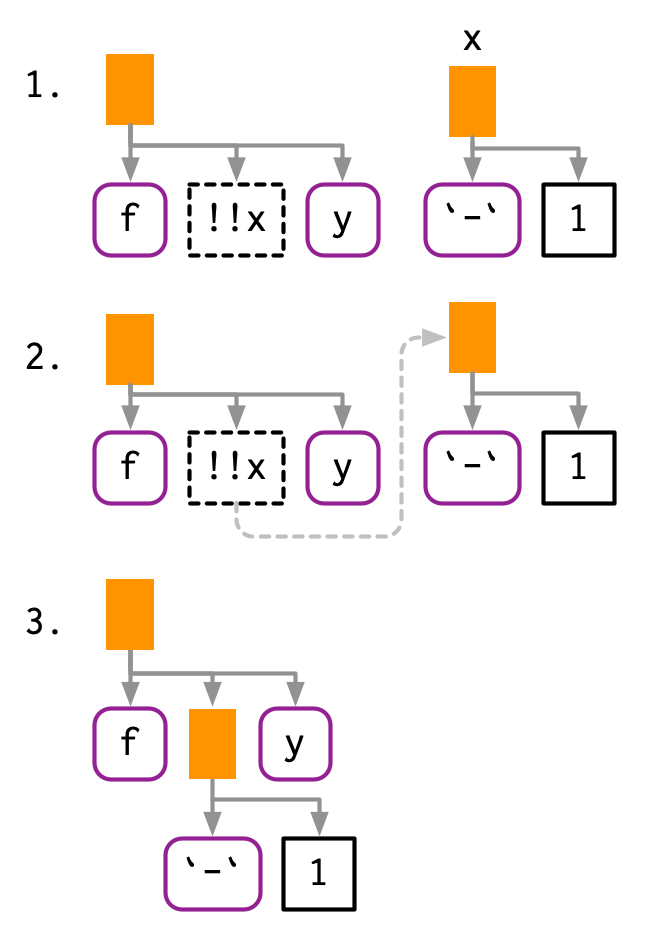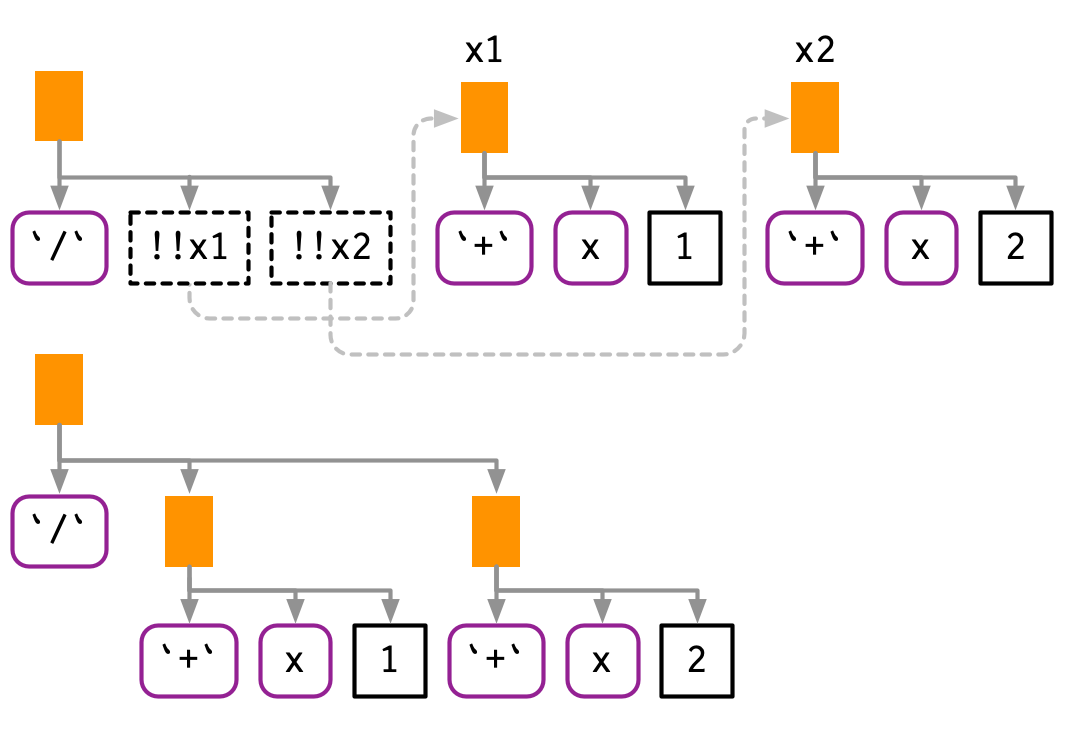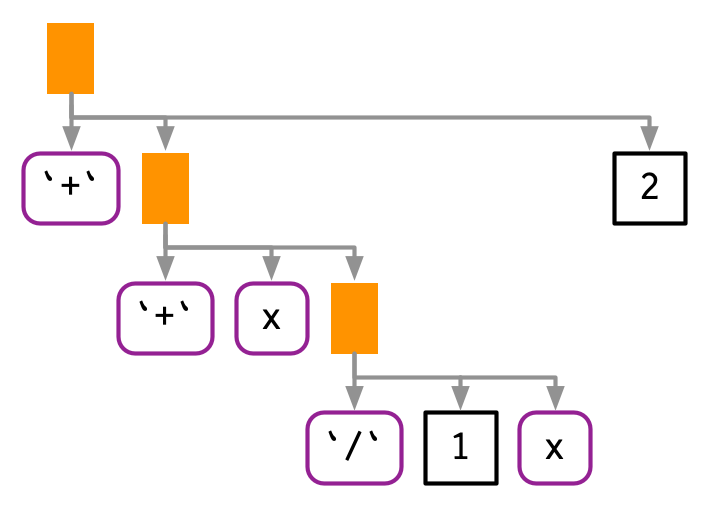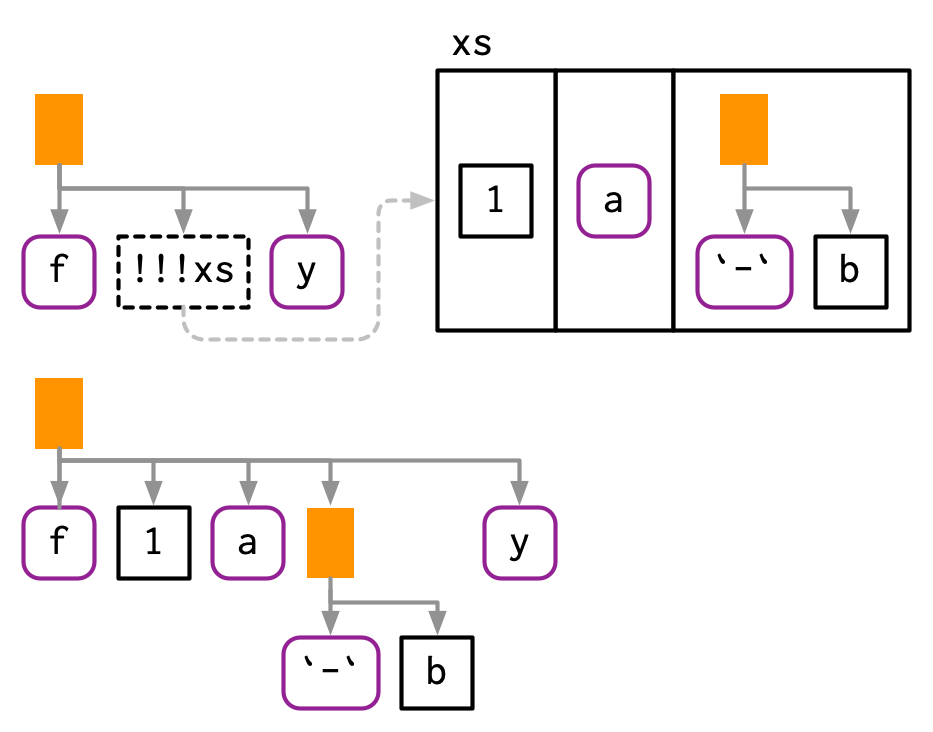19.4 Unquoting
So far, you’ve only seen relatively small advantages of the rlang quoting functions over the base R quoting functions: they have a more consistent naming scheme. The big difference is that rlang quoting functions are actually quasiquoting functions because they can also unquote.
Unquoting allows you to selectively evaluate parts of the expression that would otherwise be quoted, which effectively allows you to merge ASTs using a template AST. Since base functions don’t use unquoting, they instead use a variety of other techniques, which you’ll learn about in Section 19.5.
Unquoting is one inverse of quoting. It allows you to selectively evaluate code inside expr(), so that expr(!!x) is equivalent to x. In Chapter 20, you’ll learn about another inverse, evaluation. This happens outside expr(), so that eval(expr(x)) is equivalent to x.
19.4.1 Unquoting one argument
Use !! to unquote a single argument in a function call. !! takes a single expression, evaluates it, and inlines the result in the AST.
x <- expr(-1)
expr(f(!!x, y))
#> f(-1, y)I think this is easiest to understand with a diagram. !! introduces a placeholder in the AST, shown with dotted borders. Here the placeholder x is replaced by an AST, illustrated by a dotted connection.

As well as call objects, !! also works with symbols and constants:
a <- sym("y")
b <- 1
expr(f(!!a, !!b))
#> f(y, 1)
If the right-hand side of !! is a function call, !! will evaluate it and insert the results:
mean_rm <- function(var) {
var <- ensym(var)
expr(mean(!!var, na.rm = TRUE))
}
expr(!!mean_rm(x) + !!mean_rm(y))
#> mean(x, na.rm = TRUE) + mean(y, na.rm = TRUE)!! preserves operator precedence because it works with expressions.
x1 <- expr(x + 1)
x2 <- expr(x + 2)
expr(!!x1 / !!x2)
#> (x + 1)/(x + 2)
If we simply pasted the text of the expressions together, we’d end up with x + 1 / x + 2, which has a very different AST:

19.4.2 Unquoting a function
!! is most commonly used to replace the arguments to a function, but you can also use it to replace the function. The only challenge here is operator precedence: expr(!!f(x, y)) unquotes the result of f(x, y), so you need an extra pair of parentheses.
f <- expr(foo)
expr((!!f)(x, y))
#> foo(x, y)This also works when f is a call:
f <- expr(pkg::foo)
expr((!!f)(x, y))
#> pkg::foo(x, y)
Because of the large number of parentheses involved, it can be clearer to use rlang::call2():
f <- expr(pkg::foo)
call2(f, expr(x), expr(y))
#> pkg::foo(x, y)19.4.3 Unquoting a missing argument
Very occasionally it is useful to unquote a missing argument (Section 18.6.2), but the naive approach doesn’t work:
arg <- missing_arg()
expr(foo(!!arg, !!arg))
#> Error in enexpr(expr): argument "arg" is missing, with no defaultYou can work around this with the rlang::maybe_missing() helper:
expr(foo(!!maybe_missing(arg), !!maybe_missing(arg)))
#> foo(, )19.4.4 Unquoting in special forms
There are a few special forms where unquoting is a syntax error. Take $ for example: it must always be followed by the name of a variable, not another expression. This means attempting to unquote with $ will fail with a syntax error:
expr(df$!!x)
#> Error: unexpected '!' in "expr(df$!"To make unquoting work, you’ll need to use the prefix form (Section 6.8.1):
x <- expr(x)
expr(`$`(df, !!x))
#> df$x19.4.5 Unquoting many arguments
!! is a one-to-one replacement. !!! (called “unquote-splice”, and pronounced bang-bang-bang) is a one-to-many replacement. It takes a list of expressions and inserts them at the location of the !!!:
xs <- exprs(1, a, -b)
expr(f(!!!xs, y))
#> f(1, a, -b, y)
# Or with names
ys <- set_names(xs, c("a", "b", "c"))
expr(f(!!!ys, d = 4))
#> f(a = 1, b = a, c = -b, d = 4)
!!! can be used in any rlang function that takes ... regardless of whether or not ... is quoted or evaluated. We’ll come back to this in Section 19.6; for now note that this can be useful in call2().
call2("f", !!!xs, expr(y))
#> f(1, a, -b, y)19.4.6 The polite fiction of !!
So far we have acted as if !! and !!! are regular prefix operators like + , -, and !. They’re not. From R’s perspective, !! and !!! are simply the repeated application of !:
!!TRUE
#> [1] TRUE
!!!TRUE
#> [1] FALSE!! and !!! behave specially inside all quoting functions powered by rlang, where they behave like real operators with precedence equivalent to unary + and -. This requires considerable work inside rlang, but means that you can write !!x + !!y instead of (!!x) + (!!y).
The biggest downside69 to using a fake operator is that you might get silent errors when misusing !! outside of quasiquoting functions. Most of the time this is not an issue because !! is typically used to unquote expressions or quosures. Since expressions are not supported by the negation operator, you will get an argument type error in this case:
x <- quote(variable)
!!x
#> Error in !x: invalid argument typeBut you can get silently incorrect results when working with numeric values:
df <- data.frame(x = 1:5)
y <- 100
with(df, x + !!y)
#> [1] 2 3 4 5 6Given these drawbacks, you might wonder why we introduced new syntax instead of using regular function calls. Indeed, early versions of tidy evaluation used function calls like UQ() and UQS(). However, they’re not really function calls, and pretending they are leads to a misleading mental mode. We chose !! and !!! as the least-bad solution:
They are visually strong and don’t look like existing syntax. When you see
!!xor!!!xit’s clear that something unusual is happening.They override a rarely used piece of syntax, as double negation is not a common pattern in R70. If you do need it, you can just add parentheses
!(!x).
19.4.7 Non-standard ASTs
With unquoting, it’s easy to create non-standard ASTs, i.e. ASTs that contain components that are not expressions. (It is also possible to create non-standard ASTs by directly manipulating the underlying objects, but it’s harder to do so accidentally.) These are valid, and occasionally useful, but their correct use is beyond the scope of this book. However, it’s important to learn about them, because they can be deparsed, and hence printed, in misleading ways.
For example, if you inline more complex objects, their attributes are not printed. This can lead to confusing output:
x1 <- expr(class(!!data.frame(x = 10)))
x1
#> class(list(x = 10))
eval(x1)
#> [1] "data.frame"You have two main tools to reduce this confusion: rlang::expr_print() and lobstr::ast():
expr_print(x1)
#> class(<df[,1]>)
lobstr::ast(!!x1)
#> █─class
#> └─<inline data.frame>Another confusing case arises if you inline an integer sequence:
x2 <- expr(f(!!c(1L, 2L, 3L, 4L, 5L)))
x2
#> f(1:5)
expr_print(x2)
#> f(<int: 1L, 2L, 3L, 4L, 5L>)
lobstr::ast(!!x2)
#> █─f
#> └─<inline integer>It’s also possible to create regular ASTs that can not be generated from code because of operator precedence. In this case, R will print parentheses that do not exist in the AST:
x3 <- expr(1 + !!expr(2 + 3))
x3
#> 1 + (2 + 3)
lobstr::ast(!!x3)
#> █─`+`
#> ├─1
#> └─█─`+`
#> ├─2
#> └─319.4.8 Exercises
Given the following components:
xy <- expr(x + y) xz <- expr(x + z) yz <- expr(y + z) abc <- exprs(a, b, c)Use quasiquotation to construct the following calls:
(x + y) / (y + z) -(x + z) ^ (y + z) (x + y) + (y + z) - (x + y) atan2(x + y, y + z) sum(x + y, x + y, y + z) sum(a, b, c) mean(c(a, b, c), na.rm = TRUE) foo(a = x + y, b = y + z)The following two calls print the same, but are actually different:
(a <- expr(mean(1:10))) #> mean(1:10) (b <- expr(mean(!!(1:10)))) #> mean(1:10) identical(a, b) #> [1] FALSEWhat’s the difference? Which one is more natural?
Prior to R 3.5.1, there was another major downside: the R deparser treated
!!xas!(!x). This is why in old versions of R you might see extra parentheses when printing expressions. The good news is that these parentheses are not real and can be safely ignored most of the time. The bad news is that they will become real if you reparse that printed output to R code. These roundtripped functions will not work as expected since!(!x)does not unquote.↩︎Unlike, say, Javascript, where
!!xis a commonly used shortcut to convert an integer into a logical.↩︎